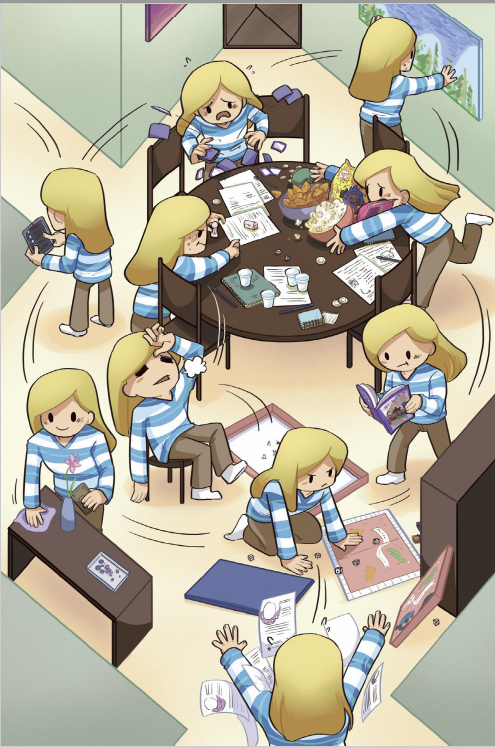Costume Fairy Adventures by hyphz
108 shades of Fey
Original SA postHey, it's another bit of a work break, so let's do another game. This time, one I think that I really like, but that I've never been quite certain about. Certainly, I'd put a positive spin on this one.
108 shades of Fey: Costume Fairy Adventures
Once upon a time, there was a game called Maid. Which was largely intended to be a light-hearted anime game about characters causing chaos, but which mostly become infamous for the risque content it included, some of which was by accident. This game also included, as an optional rule, a "costume table" which allowed a Maid character to roll to change into a random costume and gain bonuses vaguely related to what the costume represented. A gamer and RPGnetter called David Prokopetz apparently liked this aspect of the game, and wrote a cross-over parody called Eclipse Maid, which replaced the costume table from Maid with a set of morphs from Eclipse Phase - basically entirely new bodies or even body-transcending forms - in an equally silly way. (But, um, yea, it still had Pleasure Model as one of the rollable morphs.)
Costume Fairy Adventures is Prokopetz's second attempt at tweaking the same formula, but with much more dramatic changes. All of the risque or suggestive stuff, pleasure models or whatever, has been stripped out; the dice system has been overhauled; the costume system integrated into the core rules, and a great deal more structure has been added to play. The system is a strange combination of influences from sources such as Fate, Wushu, Toon, and the structure makes it almost a hybrid between a traditional RPG and a storytelling parlor game like Once Upon a Time. And that's why I like it - it's a really interesting experiment in structuring a sandbox game.
One odd thing about this book - while the rules are actually pretty simple, the book explains everything, from some standard GMing tips to social basics (like how to put out snacks for tabletop play or how to organize a game over chat or e-mail). While I get the idea that they want this game to appeal to the non-traditional RPG audience, at the same time, all that does take up quite a bit of space. The book is folio-sized, but is thicker than the similar folio-sized Fate Core, and much thicker than the older, also folio-sized, Faerie's Tale Deluxe which likewise was written for newer players and children. It's thicker than the two rules books in the new Paranoia Red Clearance set combined. It's kind of cheating, but it's also thicker than the D&D 5e Player's Handbook! (cheating because 5e is letter-sized) So it's not clear if the sheer volume of the book will itself put off the same new players that it's written to appeal to. Still, this is probably justified in that the majority of sales are probably expected to be PDF.
Also, there's a list of "influences" at the start, but there's no mention of Maid or Eclipse Phase - only of Golden Sky Stories and Fate Accelerated, which it does definitely have connections to, but still..
So. Your character. You're a fairy. All the classic tropes, foot-tall humans with wings and magic powers who are also, by and large, incredibly ditzy. Their goal in life is to cause entertaining chaos, but "almost never" causing serious harm, and sometimes helping people indirectly. Ignatius J. Reilly would be proud. Step one in making your character is to pick one of six Kinds, or you can roll if you prefer. And the Kinds to choose from are:
Fairy. The... wait, what? Oh, good grief. Yes, for some reason, in this game where everyone plays fairies, the very first kind in the book is called Fairy. And no, it's not the universal or default one. There's actually one particular kind of fairy called a Fairy. This is even worse than No Thank You Evil having a specific kind of child character called a Kid. I have no idea why on Earth they would do this. It's not like there's a shortage of general names for classic looking fairies. The book states that it uses "fairy" to mean any player character, and "Fairy" to mean the specific kind. I'm going to copy that tradition, except I'll use "fairy" for any player character, and "Fairy (head-desk)" for the Kind.
Fairy (head-desk). They're called that because they're the archetype of how most humans picture fairies. Foot tall, translucent wings, and ridiculously cunning and spry. The advantage of being a Fairy (head-desk) is that you have the most impressive wings of any Kind; you get Edge (basically a positive modifier) in any kind of mobility contest.
Pixie. Pixies are a bit bigger, more muscular, less child-like, and they have a beetle's shell protecting their wings. People immediately expect them to be troublemaking rowdies. They can fly, but not as well as Fairies (head-desk), so they don't get an Edge. Their bonus is that their Stress Limit (basically HP) is increased by 5 compared to everyone else.
Sprite. Sprites are even more slight looking than Fairies (head-desk), but tend to associate more with healthy plants, blooming flowers, bright colours, and so on. They look like complete ditzes who could maybe manage to work out where a field was and dance in it, and that's it. They can fly with no advantages, but their bonus is that they're really lucky - or, actually, they're just really good at using magic, but most fairies don't understand when they're using magic and just put it down to luck. They generate one extra Magic point whenever they generate them from a roll.
Brownie. Aha! One that actually matches folklore. Short, chubby, and earthy-coloured, and generally seen as helpers by the Big Folk, which can be pretty beneficial. They have the same neutral flight as Pixies, and their power is that.. they can change Costumes more easily, because they don't have to dress up completely, just accessorize differently. Huh. It doesn't really fit. I guess the idea that they should get on better with Big Folk wouldn't make a good power because it would be ruined if they interacted with anyone else, but still.
Goblins actually look a bit like Fairies (head-desk) except they don't have wings, at all. They do, however, have scary glowing eyes, small claws, and nasty pointy teeth. They're not actually any more evil or scary than any other kind of fairy, but they get a terrible reputation. Goblins can't fly, but they're super agile instead - scuttling up walls, over ceilings, squeezing through gaps, and doing huge jumps. Their power is that they can substitute any of their senses for any other sense, meaning they're great at hiding in dark rooms and similar, and they can't be surprised.
Elves are the rulers of all fairies. Well, they say they are. Most fairies are just humoring them and think they're a bunch of stuck-up idiots. They're a full inch taller than most other fairies, tend to have metallic coloured eyes and hair, and have no wings. They can't fly, but they can walk on air as though it were solid, leaving little puffs of sparkles and ringing bells behind. They have a power actually called "Protagonist Syndrome" - in that it's difficult to upstage them or make them look bad. What this means is that they effectively cancel out 1 point of Edge any opponent has against them.
Next steps is Stats - or, as this game calls them, Facets. Regular stats don't make a whole lot of sense for fairies - none of them are stronger than a small child and none of them are particularly smart. So instead, the five Facets represent aspects of personality and attitude - essentially, they're more like the Approaches from Fate Accelerated. Their scores range from 1 to 6, and you assign stats to them based on a standard array given in the book. Well, if you want to play properly you do. You do get the option of rolling them up as well. Unfortunately, having tested this with a quick Python script, the roll rules are exactly the opposite of what you'd want: they have a very high chance of giving you a better result than the standard array, but an only slightly lower chance of giving you worse. So some players are going to be rolling in the hay and some are going to be miserable for the whole game - almost the same problem as the 5e points buy.
The five Facets are: Moxie for being bold, brave, belligerent or just too stupid to realize you're in trouble; Focus for fine detailed work with attention to detail; Craft for complex or cunning or misdirected schemes, or complex mechanisms; Grace for avoiding screwing up both socially and physically; and Shine for just being dang lucky - either than or being really brilliant at fairy magic, and no fairy can tell which.
Next step is to pick two Quirks, one based on your highest Facet and one on your Lowest. These are basically Fate Aspects. They're freeform and give you bonuses on rolls they come up on. There's no particular rules about how they have to be associated with Facets, other than that which Facet they're associated with and its value can provide some interpretation of the Quirk. The book provides a whole bunch of sample Quirks, but none of them have any custom rules; they're just general descriptors.
You can draw a picture of your fairy if you want to. You also need to write down their Stress Limit (which is their hit point total), which is 15 if you're a Pixie and 10 if you're anything else. And you're done!
But what about the other half? What about the Costumes? Well, that's where things get unusual. Costumes aren't part of a character; they're randomly handed out at the start of each game. By default, they're printed on cards. The game comes with a deck of 108 costume cards, and each player gets 3 handed to them at the start of the game. (The game has alternative rules for rolling them up if you don't want to use the deck - you just need to check that a costume you've rolled isn't already in someone else's hand, but there's no particular need to track discarded ones.) At that point, the player chooses one that their fairy's wearing at the opening of the story. They can change costume to one of the others in their hand any time their character's off camera (and the previous one isn't discarded), or spend points of Magic to quick-change in the middle of a scene. They can also scrounge up new costumes, either automatically when a character's off camera, or in the middle of a scene if it's an appropriate place for a fairy to find stuff to make a costume out of (possibly requiring a roll). The maximum hand size is 3, so finding a new costume will mean discarding an old one.
What does a Costume actually do? It gives you two additional Quirks that you can stack with the two you have on your character, and it gives you one or more special moves. Some of these are unrestricted, but more often they require either spending Magic or - for the more powerful cases - discarding the costume completely when you use them. (You can't discard your last costume, though. No naked fairies allowed.)
So, to see what we actually do with all of these, post 2 will cover the actual dice rules, and maybe a bit of the structure rules too (as I said, the book takes a lot of space explaining how to use the rules, but they're actually really simple).
Everything is a talent of the Platypus
Original SA post Costume Fairy Adventures, 2: Everything is a talent of the PlatypusFirst things first: tidying up a few things from the previous post. First of all: art! We has it.
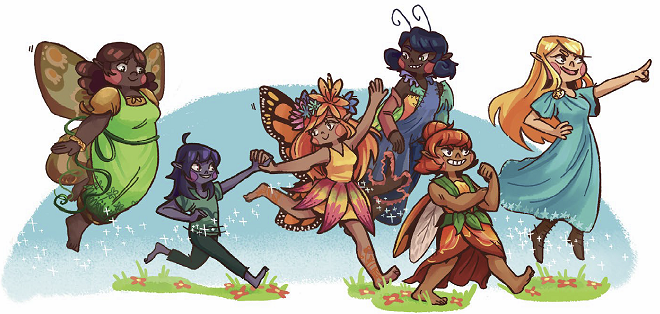
Left to right: Brownie, Goblin, Sprite, Fairy (head-desk), Pixie and Elf. There's quite a lot of art in the book and PDF - it's the other big contributor to the book's thickness, and most of it's good, although some of it's.. a bit too simple for its own good.
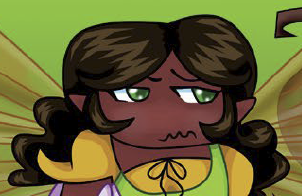
Second, a bit of missing history. It turns out that a very early version of CFA was actually written just a few months after the first draft of Eclipse Maid as a 24-hour RPG called Fairy Cosplay (it's not clear if it was entered in a 24-hour RPG contest or if Prokopetz just did it in 24 hours because he wanted to) and inspired by a post in a Touhou thread on RPG.net.
David Prokopetz posted:
So here is my RPG about cosplaying fairies. May God have mercy on us all.
Fairy Cosplay has been mostly expunged from the Internet, although there are a few traces on the Wayback Machine. Unfortunately, Wayback doesn't do PDFs, so the rulebook itself has been lost, but there is an ancient playtest thread on RPG.net. A fair amount seems to have changed since then, although the idea of the five Facets remains - although originally Moxie was called Spunk, Shine was called Luck, and Charm was called (ready for a groan?) Moe.
Lastly, there's the gender issue. Although it's assumed throughout the book, the book never actually states outright that all fairies are female. Many of the costumes are female-specific but could be fairly easily patched across if they needed to be, and there's *maybe* one illustration of a male fairy? It's not quite clear, and I'm guessing the general idea is "don't sweat it".
Ok? Let's roll some dice.
By the way, did I mention that in this book, every time a term is mentioned in rules text, there's a note in a sidebar telling you what page to find the rules for the related term on? And if you're using the PDF, that sidebar is a link to that page? Well, there is and it's great.
Here's how you dice in CFA. Pick a Facet to roll. The sandbox structure of the game encourages PCs to act proactively, so hopefully it's the player determining the Facet, but the GM can determine it if a sudden reaction is needed. You get one base d6 to roll, and you want to roll your Facet score or less. The higher you roll without going over your Facet, the better the result is (it's the Price is Right system from Unknown Armies but with d6s, essentially). If you go over, you fail.
However, where the Wushu influence comes in is that you can get more dice. You get more dice by "tagging" Quirks - that is, pointing out how a Quirk can relate to your action in the current situation. You can tag one Quirk from your character, one from your Costume, and one from your Location. If someone's helping you, you can tag one of their Quirks as well (if it's another PC, it can only be from their character or their Costume, though); and if you're working against someone else and you can argue that one of their Quirks disadvantages then, you can tag that too. So that's up to 6 dice you could be rolling. You get to pick the best one - that is, the one that's nearest your Facet without going over.
Also, magic! You start each session with 3 magic points and you can spend 1 before any roll to add an extra die to it (once). You get magic back by.. making bad rolls. For every 6 that shows in a roll, you get a point of Magic, and the GM gets a point of Trouble. Since Facets can't rise as far as 6, any such dice is a guaranteed failure, but hopefully it's not the best dice in the set you rolled.
If it's an unopposed roll, then if you got a success at any level, you succeed - which means you get to narrate the outcome. If you fail, the GM gets to narrate. It's stated that you're not actually required to narrate your success, nor is the GM required to narrate your failure, but it's generally open provided it's actually something to do with what you were trying to achieve and it doesn't directly interfere with another PC. Also, if another PC objects to what you're doing for other reasons, they can trigger a retroactive contest, in which their fairy tries to flit over and mess with you after it's become apparent what you're doing. This turns the roll into an opposed roll, but you get to keep your original result. The book does say that this should usually be used when it wasn't clear from the original statement of action what you were planning, and that it's "bad form" to pounce on an action you wouldn't have liked to begin with after you've seen the roll was bad. I don't like rules that require social shoring. This makes me sad.
If it's an opposed roll, then whoever rolls the highest success wins. So I hope you're careful if you're taking on someone with a higher Facet, because they can roll numbers higher than you're even allowed, no matter how many Quirks you tag! As before, the winner gets to narrate, and can make stuff happen to the opposition, but can't directly state what they do or take them out of play. Also, we mentioned Edge before; Edge is a bonus you add to your success result in an opposed roll to determine the winner. It doesn't turn a success into a failure, but it can compensate for a facet being lower. Also, if you manage to ambush your opponent completely, you can treat this as an opposed roll where they fail.
In addition, there's Stress. We mentioned that every PC has a Stress Limit; 15 if you're a Pixie, 10 if you're anything else. If you fail an unopposed test, the GM can hit you with Stress (1d6 in the worst case); if you fail an opposed test, you automatically take Stress equal to the winner's Result - even if the winner would rather you didn't. If you exceed your Stress Limit, then you're Stressed Out, which means you lose your active Costume and you have to sit out of the action for five real-time minutes (or five posts on a forum game), a la Falling Down in Toon. If something bad was obviously going to happen to your fairy, you can have that happen (they get squashed or swatted or whatever); if you can come up with something that happens, like them going off to sulk, you can do that too; and as a last resort, you can have a Stress Explosion. No, not Maid style. You literally explode into a shower of rainbows. Them fairies is unstable. You still get to come back after a few real-time minutes, though.
You can heal all your Stress by resting for a few hours, or you can recover 1d6 Stress by eating something. Fairies eat the same stuff humans do, and the same sizes of meal - so yes, they could quite easily be devouring their own weight or more.
In addition to Stress, you can also end up with Temporary Quirks, which are just like temporary Aspects in Fate. They act like regular quirks, and they count as their own category for the purpose of being added to rolls - on either side. They go away more or less when it makes sense they would based on what they are; or you can force them away by giving up at least 3 points of Stress recovery. You can also only have 3 at a time, so extra Temporary Quirks just fall off. The book also adds that fairies are somehow aware of this and deliberately overflowing themselves with Temporary Quirks is something they may do deliberately in order to lose particularly negative ones.
There's no Combat system in particular. Combat is referred to as "scuffling" but it's just another opposed roll, so there's no tactical positioning or initiative or anything like that.
An unusual feature of the game is that there's an explicit rule set for being off camera: a Break. A break happens if your character isn't doing much for a while, or if you actually leave the table or - on an online game - don't respond for a while. If you actually leave the table for a Break, then you don't get an update on the situation when you come back; since your fairy ducked off-camera, she comes back with no idea what's going on, which can apparently be hilarious (if it's not godawful frustrating). You can rule that while you were on Break, your fairy found one new costume; changed costume; and/or ate food to heal Stress, provided you can explain where she found unguarded food. If you Stressed Out, that counts as a Break, so you can do all these things too; although there's not a lot of point eating to heal Stress since you come back with your Stress fully healed, and you're going to have to change costume because you lost the one you were wearing when you Stressed Out. If there's a time gap in the narration that would logically allow everyone to take a Break, that's an Intermission, and it.. well, allows everyone to take a Break with no real-time constraints.
We've touched on Magic previously - that it can be used to add dice and change costumes while in-scene - but there's also overtly using magic. Wishful Thinking costs 3 Magic points, and has your fairy overtly trying to arrange that something happens (which can consist of twirling wands and muttering mumbo-jumbo if you want, but can also just consist of blindly flying in and hoping to God for a coincidence). You make an unopposed roll, and if you succeed, stuff goes your way. If you fail, stuff goes really badly.. although the GM is explicitly not allowed to hit you with Stress or Temporary Quirks for failing at Wishful Thinking; it just causes really bizarre sidetracks in the story. There's a few limitations about what you can Wish for - no instakilling other Fairies, etc - but the GM is only allowed to do the Evil Genie thing if you fail. (Also, the game says that if a fairy PC is silly enough to try to make a persuasion roll against another fairy PC, you should allow it, but the target is absolutely allowed to Evil Genie the heck out of it - because, hey, in folklore fairies did exactly that, right?)
One last mechanic we have to deal with - and apart from a few guidelines about how to roll for NPCs, this is the only rule in the GMs section of the book - is those Trouble points. (NPCs usually only have a couple Facets and can't use the others; they don't generate Magic or Trouble; they spend Trouble instead of Magic; mooks Stress Out if they suffer any stress at all, but bosses can have Stress Limits, although usually only 5 or so) Trouble points (which are called Trouble Dice for some reason, even though they're only used as dice in one potential situation) are spent for several reasons: to add dice to NPC rolls (unlike Magic, NPCs can spend several of them on a single roll); to invoke a Quirk against a PC in an opposed or unopposed test, losing them a die in the process; or to add a complication to a PCs narration, provided it doesn't undo what the PC was trying to do. For 3 Trouble, the GM can have an opposing NPC or hazard show up, even if it makes absolutely no sense for them to have done so or if they were Stressed Out earlier in the adventure.
And finally, for 5 Trouble, the GM can Invoke Disaster. This immediately redirects the entire scene onto a new occurrence - based on a random roll on a table. Yep, it's random events from Maid, but on the GM's side only. As an example, the given disaster table for an "Enchanted Forest" style game consists of: earthquakes rearranging the forest, the forest gods raging against the fairies personally, bandits showing up.. or encountering a girl who's in the middle of having her fairy-tale protagonist backstory and is downright dangerous to be around as a result. Some fun concepts, but could easily misdirect an entire session.
Ok, enough of the wall of rules text. Let's break up things with some reviews of a few Costume Cards. Start with a good one:
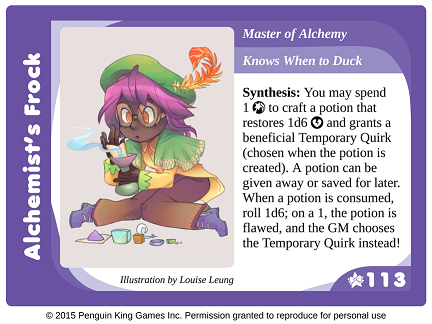
Here's your typical Costume Card. Relevant Quirks and a thematic triggered Power with a reasonable effect. No problems. Unfortunately, they aren't all like this - although a decent proportion are.
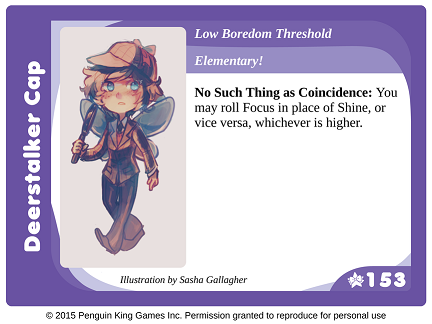
Oh look. It's a Stat Swapper. There's quite a few of these for different combinations of Facets, and they're all going to have the same problem that they can either be absolutely brilliantly awesome if one of those Facets is good, or utterly awful if they're both meh or the same. You can of course draw a new Costume, but that doesn't help if one of the other players drew their perfect combination.
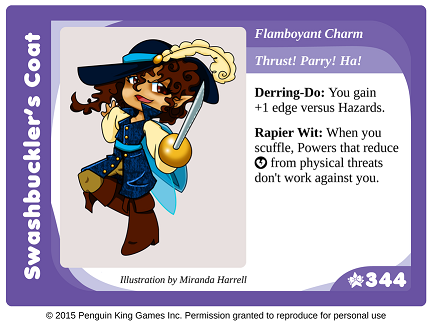
Let's all fight a lot. One of quite a few Costumes that have a power dependent on being in a Scuffle - that's combat. Which kind of gives the lie to the whole "combat's just another roll" thing. Also, is our fairy potentially stabbing someone with a rapier here? Because while fairies are fun, fairies with sharp objects are terrifying; just ask the Dresden Files artists.
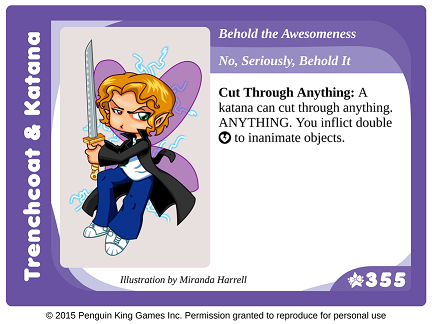
Absolutely my most disliked Costume Card in the game. Not only does it effectively have only one Quirk, but its power is incredibly situational, because it's dependent on the GM deciding to treat an inanimate object as a hazard and giving it a Stress Limit.
And lastly, there's this thing:
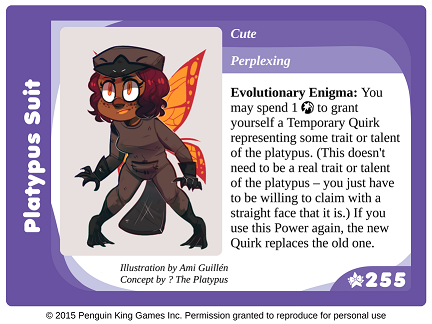
Everything is a talent of the Platypus. It isn't particularly unbalanced to be honest (it costs a Magic, which could have bought you an extra dice on a single roll anyway, so actually benefitting requires some thinking ahead to determine a Temporary Quirk that'll be useful in multiple situations), but still in a comedy game like this is it really going to be any restriction? Or, I guess, you could use it to give your fairy poisoned spines that inflect pain so excruciating that Morphine cannot dull it.
Next time - we'll look at the sandbox structural rules, aka the simple bit that suddenly makes everything really interesting.
How to Score with Fairies
Original SA post Costume Fairy Adventures, 3: How to Score with FairiesZorajitZorajit posted:
The Dark Elves of Norse myth share some of the same stories as the Black Dwarves of Germanic myth and the faeries of Celtic myth. Which is not to suggest those are all the interchangeable. But Elf / Faerie / and Goblin meant the same thing for thousands of years until nerds codified them.
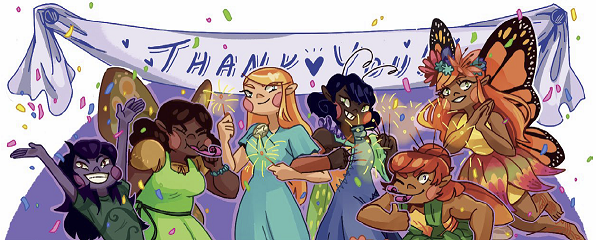
(Although I guess some of those nerds were Victorian artists.)
So, here's the bit I've been holding off on a bit. We have these general rules, we have the Costume Cards, and then we have the neat bit that galvanizes this all into action.
Costume Fairy Adventures is played for score.
Well, it doesn't have to be. If you just want to hang around and do random stuff, that's fine too. But the designed game includes a scoring mechanic. The points scored are called Mischief Motes. They don't necessarily level your character up in the process, although there is an optional set of rules where they do.
The way you score points is by accomplishing Shenanigans, which is a horribly awkward word to have to use regularly at the table, but there it is. A Shenanigan is a goal - or the book describes it as "a dare" - to achieve something in the setting, usually the sillier the better. Fairies have an intrinsic sense of what's likely to cause the most chaos or confusion in an area, which is essentially an excuse for the GM to openly list any Shenanigans they have in mind in a given setting. Players can also suggest them themselves, although usually this must be done before the activity rather than after.
This also means that CFA doesn't have any prefab adventures. Instead, it has Playsets, which are prefabs sets of Locations, Shenanigans for those locations, and commonly a Disaster table as well. There may be an ongoing story as well that the fairies interact with, but it's basically down to proactive tasks.
I love this. It's an incredibly simple mechanic but it's brilliant - it keeps everything moving, gives the players goals without tying them to the railroad of an adventure plot (in fact the typical shenanigan will specifically involve making the train jump the tracks), and offers active motivation. It's the best antidote I've ever seen to the tired old saw that "this game's not supposed to be railroaded but the sample adventure is because we can't think of everything your players might do". Strangely enough, it turns out that turning this on its head - explicitly telling the players to have their characters act out as much as possible - ends up substantially helping the problem. Who'da thunk it?
So, the number of motes scored for a Shenanigan is based on how complicated it is.. and here's where I start to like things a bit less.
A 1 Mote Shenanigan is something that can be casually done, or repeated multiple times - although it can only be scored 5 times in a session. Usually this is just a side action or a running gag. A sample one is: "mix up a ridiculous cocktail and have a human drink it".
A 2 Mote Shenanigan is an opportunistic act that doesn't necessarily need a roll or challenge. If a player comes up with something neat on the hoof, it's probably a 2 Moter. A sample one: when a fairy's won a duel, having them make a wicked smile at the Crown Princess so she blushes a bit. Um, hang on, what happened to the fairy gender thing there?
A 5 Mote Shenanigan is a typical extended opportunity built into a scene or location. The assumption is that these will require..
Ugh. "At least three rolls, or one appropriate use of Wishful Thinking". And there a lot of my positive mood fades away. They're just judged by number of rolls? There is an alternative rule set where Shenanigans get a Stress Limit and are attacked in the same way other things would be, but the fact that this is so generic is rather disappointing. That said, some of the provided Playsets do include specific resolution rules, but it seems very vague. The sample given is "arrange a suitable gift for a baker to pay back for a pie that was stolen by fairies".
A 10 Mote Shenanigan is a major story-changer, something that's part of the basic assumptions of the setting. It requires five or more successful rolls (ugh) or multiple Wishful Thinkings. The given example is: "have the Empress appoint a fairy as Admiral of the Fleet".
Finally, a 15 Mote Shenanigan is either a secret one that requires extra effort to discovery, or else just a regular Shenanigan that the GM really, really wants the fairies to engage with. The book does say that overusing this can come down to railroading, but a small amount's ok.
There's a couple of other special rules. If PCs make an opposed roll against each other as part of trying for a Shenanigan, it counts as a success towards the Shenanigan no matter who wins. This is because fairies fighting each other is funny. Secondly, if PCs try to complete a Shenanigan too quickly, the GM gets a couple of options to rebalance the situation. One is to reclassify the Shenanigan at a lower score, but this is not recommended, because it penalizes the player for having a neat idea. The alternative is to warn the player that they're lowballing the Shenanigan, and if they go ahead anyway, the GM gets 2 trouble points for every roll less than the specified number made. Lack of trouble now means more trouble later.
Also, if the idea of simply having "a given number of rolls" isn't appealing, there is an alternative alternative ruleset where players can take action to create quantifyable Advantages. Advantages aren't Fate-like Quirks; they're considered Powers that allow a special action in a given circumstance, provided there's been some setup beforehand. The game divides these into three power categories, and gives suggestions for each, but they're basically fairly free.
So, overall.. I'm still kinda positive about these rules, but a bit less sure than I was. The idea of directing play in this way while maintaining the sandbox feel by offering a large range of explicit goals is neat, but I'm not at all sure about the "minimum roll count" as a way of scaling them, and the rules on giving extra Trouble still seem unnecessarily penal - although at the same time, from GMing experience in other games, I know exactly where they're coming from.
So, one last thing to look at:
The competitive rules.
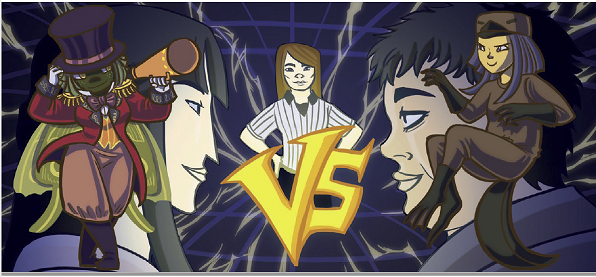
Remember how I said CFA could resemble a storytelling parlor game at times? Well, the competitive rules take it that way logically. It has a couple of different settings: a free-for-all for who is Best Fairy, a team game, or having all of the fairies together up against an NPC conspiracy that can ruin all their plans.
First of all, in competitive mode you take turns in rounds. The GM goes first, and from there you go clockwise round the table. On a turn, you can make one Test that's proactive action; initiate a Contest; use Wishful Thinking once; hit someone else with a Power; change your Costume, or scrounge a Costume; eat unguarded food to heal stress; or take a Break if you're in a safe area (being around the other fairies in a competitive game isn't considered safe). Being drawn into a contest or having to make a Test for something that happens to you doesn't take up your turn. Quick Changing lets you take an action in the same turn you change costume; if you exceed your Stress Limit, you skip your next turn for the enforced Break.
Moving is abstracted: you need to have a general map divided into areas. On your turn, you can move to an "adjacent" location (adjacent in quotes since you can probably fly) as well as taking an action, or spend your whole turn to move anywhere on the map, provided moving doesn't require a Test (in which case your turn will be spent making that Test).
If fairies are competing, then the Shenanigan roll counts are "locked down" and can't vary, and there's no option to take Trouble - the Shenanigan straight up can't be completed in less than the required number of roles. Whichever fairy makes the final roll gets to complete the Shenanigan - on the grounds that this tends to result in the fairies getting into fights just before it finishes.
On the GMs turn, they can spend Trouble, and if there's an NPC conspiracy in play, it advances. This is usually represented either by a time (round) limit, or by a "tension limit". A tension limit acts the same as a round limit, except that on the GMs turn they can provide a special Shenanigan to suspend the count for that round. Alternatively, you can just count up accumulated Trouble points, although this has the problem that it tends to result in action slowing down rather than speeding up when the limit gets close.
So.. again, I'm not quite sure about these rules. Turn-taking rules in RPGs can end up going disasterously wrong, as with the infamous skill challenges in the original printing of D&D 4E, and there's few guidelines on how to write balanced scenarios, which could result in skewed results.
And, overall, I think we can leave CFA there. There's a bunch of random tables with suggestions for three different settings, and while they're pretty silly, that's all in keeping with the flavor of the game. There's also a couple provided Playsets, but I don't really want to go through those because it would inevitably spoil them, and probably the vast majority of play I see of this game online is focussed on one or both of them. It's a game I'd honestly like to run at some point, if I could ever actually sell it to a group, which admittedly seems unlikely. But, I hope some people have found this informative and/or entertaining to some degree.
Just to finish with, have the art showing their (apparently) recommended prep process:
